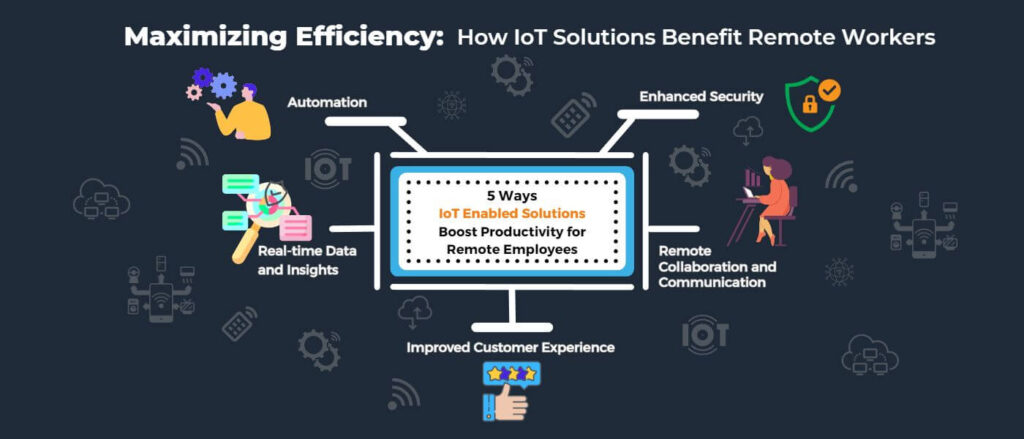The Internet of Things (IoT) is a vast network of interconnected devices, vehicles, and other objects that are infused with sensors, software, and connectivity, allowing them to gather and exchange data. These IoT enabled solutions have the potential to transform the way we work, particularly for remote employees.
Think of the IoT as a vast web of information, constantly flowing and updating, connecting the physical world with the digital. Imagine the endless possibilities of what we can do with all this data at our fingertips. We can automate tedious tasks, gaining back precious time to focus on more complex and creative endeavours. We can access real-time data and insights, enabling us to make informed and efficient decisions. And we can stay connected and collaborate with our team, regardless of where we are in the world.
The IoT is revolutionizing the way we work, and for remote employees, it can be a game-changer. No longer are we limited by geography or resources. With the IoT, we can work smarter and more efficiently, staying connected and productive, no matter where we are.
Here are five ways in which IoT enabled solutions can boost productivity for remote employees:

- Automation
Automation is one of the key ways in which IoT enabled solutions can increase the productivity of remote employees. By using sensors and other IoT technologies, certain tasks can be automated, freeing up time and energy for employees to focus on more complex and creative tasks. This can be especially beneficial for remote employees, who may not have the same level of support and resources as on-site employees.
One example of how IoT enabled solutions can automate tasks is through the use of smart office or storage buildings. These buildings use sensors and other IoT technologies to automatically adjust the temperature, lighting, and other environmental factors based on the preferences and needs of the employees or the goods housed in the rooms. This can not only improve the comfort and wellbeing of employees, but also eliminate the need for manual adjustments, saving time and effort.
Another example is the use of IoT enabled supply chain management systems. These systems use sensors and other technologies to automatically track and reorder inventory, reducing the time and effort required for manual inventory management. This can be especially valuable for remote employees, who may not have the same level of access to physical inventory as on-site employees.
- Real-time Data and Insights
Real-time data and insights are another way through which IoT enabled solutions can assist in increasing the productivity of remote employees. By providing access to real-time data, employees can make more informed and efficient decisions, improving their productivity and effectiveness.
One such instance of IoT enabled solutions providing real-time data and insights is through the use of fleet management systems. These systems use sensors and other technologies to track the and status of shipments, allowing employees to optimize routes and schedules, and reduce the time and effort required for manual tracking and coordination.
For example, if a shipment is running behind schedule, an employee can access real-time data on the location and status of the shipment, and make adjustments to the delivery route or schedule to minimize delays. Similarly, if there is a problem with the shipment, such as damage or loss, an employee can quickly identify the issue and take action to resolve it, improving efficiency and minimizing the impact on the customer.
- Remote Collaboration and Communication
Remote collaboration and communication are a crucial aspect of the modern workforce, and the IoT is revolutionizing the way we stay connected and work together, regardless of location.
Imagine being able to join a meeting from anywhere in the world, as if you were in the same room as your colleagues. With an IoT enabled conference room, this is possible. Sensors and other technologies can capture and transmit audio, video, and other data, allowing you to participate in meetings and collaborate with your team in real-time. You can share ideas, discuss projects, and even brainstorm together, all from the comfort of your own home or office.
Or consider the power of being able to track and share progress, assign tasks, and collaborate on documents in real-time, regardless of where you are. With an IoT enabled project management system, this is possible. You can access real-time data on the status of projects, see what your colleagues are working on, and collaborate on documents and other materials, all from your computer or mobile device.
Overall, the IoT is enabling remote employees to stay connected and work together effectively, regardless of location. Whether it’s joining a meeting, tracking progress, or collaborating on documents, the IoT is transforming the way we work and stay connected.
- Enhanced Security
The security of remote work environments is an increasingly important issue, and IoT enabled solutions can help to improve security in a number of ways.
One way in which IoT enabled solutions can enhance security is through the use of security systems that can monitor and alert employees to potential threats, such as unauthorized access or suspicious activity. For example, an IoT enabled security system could use sensors and other technologies to detect and alert employees to potential threats, such as unauthorized access to a building or computer system. According to a study by the National Institute of Standards and Technology, the use of IoT enabled security systems can significantly reduce the risk of security breaches and other threats, making them a valuable investment for any organization.
In addition to detecting and alerting employees to potential threats, IoT enabled solutions can also help to protect against data breaches and other security threats by encrypting data and implementing strong cybersecurity measures. For example, an IoT enabled customer service system could encrypt customer data to protect against data breaches and implement strong passwords and other security measures to prevent unauthorized access. According to a report by the Cybersecurity Ventures, the cost of a data breach can be significant, with the average cost for a small business estimated at over $200,000. By implementing strong cybersecurity measures, businesses can significantly reduce the risk of a data breach, protecting both their own and their customers’ data.
- Improved Customer Experience
The IoT isn’t just about automating tasks and improving efficiency, it can also help businesses to provide a better customer experience. Imagine being able to resolve customer issues in a flash, or tailoring your products and services to their exact needs and preferences. With IoT enabled solutions, this is possible.
Consider this. You’re a customer, trying to place an order on a website, but something goes wrong. You’re frustrated, and you want to get the issue resolved as quickly as possible. With an IoT enabled customer service system, an employee can access real-time data on your interactions, quickly identify the problem, and resolve it on the spot. No more waiting on hold or sending emails back and forth. The issue is resolved, and you can go about your day with a smile on your face.
Or imagine you’re a business owner, trying to understand what your customers want and need. With IoT enabled solutions, you can gather data on customer interactions, preferences, and behavior, allowing you to tailor your products and services more effectively. No more guesswork or assumptions. You have real data to guide your decisions, and you can be confident that you’re meeting your customers’ needs and preferences.
Therefore, the IoT can significantly improve the customer experience by enabling businesses to respond more quickly to customer needs and issues, and better understand customer preferences and needs. So don’t be afraid to embrace the IoT. Your customers (and your bottom line) will thank you.
Closing Thoughts
In conclusion, IoT enabled solutions have the potential to revolutionize the way we work, particularly for remote employees.
By automating tasks, providing real-time data and insights, and enabling remote collaboration and communication, these solutions can significantly increase the productivity and effectiveness of remote employees. They can streamline and optimize workflows, improve efficiency, and enhance the security of remote work environments, providing a range of benefits for both employees and businesses.
Of course, there are challenges to consider when implementing IoT enabled solutions. One of the key challenges is the need for strong cybersecurity measures to protect against data breaches and other security threats. It’s essential to ensure that data is encrypted and that strong cybersecurity measures are in place to protect against unauthorized access.
Another challenge is the cost of implementation. IoT enabled solutions can require a significant investment, including the cost of hardware, software, and other infrastructure. It’s important to carefully consider the potential benefits and costs of implementing these solutions, and to ensure that the investment is justified.
However, the challenges of implementing IoT enabled solutions are severely outweighed by the potential benefits. These solutions can significantly improve the productivity and effectiveness of remote employees, and are a valuable consideration for any organization looking to optimize the productivity of their remote workforce. By embracing the IoT, we can revolutionize the way we work, and stay connected and productive, no matter where we are.


